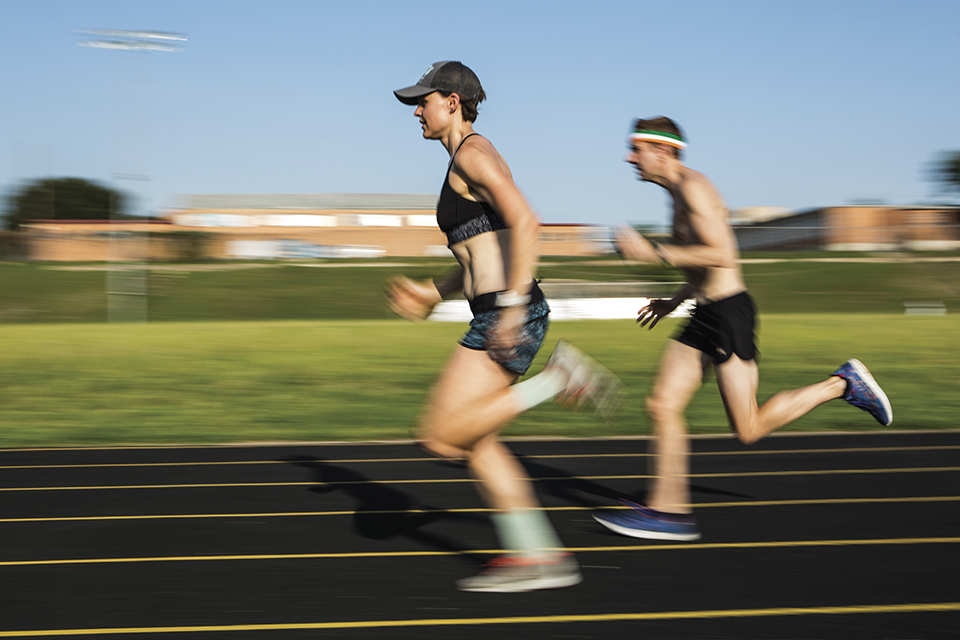Recovering from Injury

It’s not uncommon for competitive athletes to encounter a dramatic injury at some point in their career. A broken bone, pulled muscle, or torn ligament can derail training regimens and sideline all ambitions in a matter of seconds. Without question, that kind of injury requires rest, recovery, and rehabilitation. The nagging injuries—the most common kind, often resulting from overuse—however, are an entirely different story, and present their own set of challenges on a mental and physical level.
Cate Barrett fought that battle for years. As a collegiate athlete competing in track and cross country at Baylor University, Barrett’s life was anchored by running. That is, until she encountered her first serious injury. Leading up to her senior year, Barrett spent the summer at a training camp in Colorado; the intensity of the program took her mild heel pain, turned it into a stress fracture, and constricted her to a boot.
“I took six months off completely, didn’t run, got depressed, and had the worst year of my life,” Barrett remembers. “And I wasn’t taking care of myself so naturally, it got worse.”
She admits that it was tough to manage the diagnosis because, at the time, she didn’t have the tools to cope with such a drastic shift. A half year went by, and Barrett felt trapped in a pit of self-pity. Not only did her final year as a Division I athlete not pan out as she had hoped, but her plans to join a post-collegiate professional team seemed overzealous, especially without any recent times to show. Fortunately, things took a turn when Steve Sisson, founder of Rogue Running, gladly welcomed a freshly healed Barrett to the Adidas-sponsored team, Rogue Athletic Club.
She ran with Rogue AC until the team disbanded, but still had the motivation to race. In early 2016, though, a persistent pain creeped up on her. By spring, she had abruptly ended her track season due to heel pain, and later faced knee problems that interrupted her training plans.
Barrett revised her schedule to cycle through two to three weeks of working out, then take a break for two to three weeks, in an attempt to manage the pain. By September, she was racing again, and took home a 2nd place finish at Spectrum Trail Racing’s Sky Island 25K. But the real accomplishment for Barrett actually came from the start-to-finish feel-good miles.
The victory was short-lived. “I was just having a little arch pain, and then I did a race in December that aggravated it. I could feel the level of irritation—going too far over the line. That day did it for me,” she says.
While Barrett watched her husband and friends do hometown favorites like the Austin Half-Marathon and the Cap10K, she focused on setting some personal goals. Barrett refused to fall victim to the negativity affiliated with the perpetual cycle of injuries. In her search for a solution, she came across a blog post written by a World Champion Spartan racer that struck a chord with her.
“She wrote about coming back from injury and instead of trying to get back to a former version of yourself, recreating yourself as a new athlete. And that was something that I’ve tried to do a lot,” Barrett says. “What if, instead of saying, ‘Oh, I’m just a washed up ex-college runner who can run this, this, and this,’ I was just discovering running for the first time? I chose to look at it like, ‘Hey, I just did a workout at this pace.’ Wouldn’t you be so proud of yourself if you didn’t have all of that experience in the past or those expectations?”
For people who are devoted to their activity, any injury—big or small—can feel like a death. They go through the stages of grief, and the denial can be a major impediment until the severity thrusts them into acceptance. Even minor injuries will catapult an athlete into a vortex of extreme lows. The fix: looking at it as an opportunity, as Barrett learned. Rather than being at a standstill, take that time to find balance, explore an interest, or fall in love with your sport all over again. After all, distance makes the heart grow fonder.






